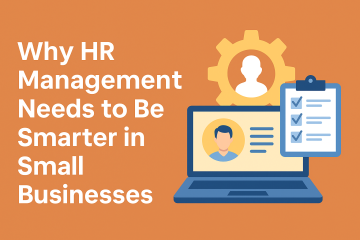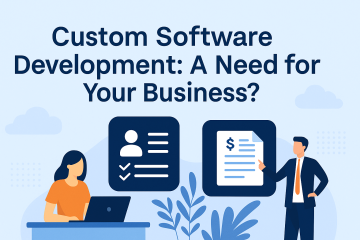Introduction for Human Resource Management System
Managing employee attendance is one of the core responsibilities of HR departments. Accurate attendance tracking ensures productivity, compliance, and proper payroll processing. However, traditional methods, such as manual timekeeping, are prone to errors and inefficiencies. Modern solutions like a Human Resource Management System (HRMS) streamline attendance management and make the process more efficient and transparent.
For businesses in bustling hubs like Delhi, partnering with a reliable software company in Delhi ensures that HRMS solutions are customized to meet local business requirements. This article explores the best practices for managing employee attendance using HRMS and how it can benefit your organization.
1. Automate Time and Attendance Tracking
Automation is the cornerstone of effective attendance management. An HRMS enables real-time tracking of employee attendance through features such as biometric integration, RFID cards, and mobile app logins. Automating time tracking eliminates manual errors and ensures that attendance data is accurate.
Best Practice:
Implement biometric systems integrated with your HRMS to track employee clock-ins and clock-outs. This method ensures reliability and prevents time theft or buddy punching.
2. Establish Clear Attendance Policies
A well-defined attendance policy sets the foundation for consistent attendance management. With an HRMS, organizations can document and communicate these policies to employees. The system allows companies to define rules for working hours, overtime, and leaves.
Best Practice:
Use the HRMS to notify employees of attendance policies, ensuring that all team members are aware of expectations. The system can also send automated reminders about upcoming holidays or unused leaves.
3. Enable Employee Self-Service Portals
Employee self-service portals empower employees to access their attendance records, leave balances, and work hours. With a human resource management system, employees can log in to their accounts, apply for leave, or check their attendance data, reducing dependency on HR staff.
Best Practice:
Encourage employees to regularly review their attendance records through the HRMS self-service portal. This transparency helps identify discrepancies early and builds trust between employees and HR.
4. Implement Mobile Attendance for Remote Workers
With the rise of remote work, managing attendance for off-site employees has become a challenge. An HRMS equipped with geolocation features or mobile app integration allows remote workers to mark their attendance from anywhere. This flexibility ensures that attendance tracking extends seamlessly to hybrid or fully remote teams.
Best Practice:
Choose an HRMS with GPS-enabled mobile attendance tracking. This ensures that remote employees can log their work hours accurately while maintaining transparency.
5. Track Overtime and Late Arrivals
Tracking overtime and tardiness is critical for maintaining productivity and fair compensation. HRMS systems can generate detailed reports on employee attendance patterns, including overtime hours and instances of late arrivals. This data helps HR teams identify trends and take corrective actions when needed.
Best Practice:
Leverage the HRMS reporting feature to monitor and analyze trends in attendance, such as frequent tardiness or excessive overtime. Use this data to address issues promptly and support employee productivity.
6. Integrate Attendance Data with Payroll
Attendance management directly impacts payroll processing. An HRMS integrates attendance data with payroll systems, ensuring that employee wages are calculated accurately based on hours worked, overtime, and leaves taken.
Best Practice:
Set up automated payroll calculations in your HRMS to reduce errors and ensure timely payments. This integration not only simplifies payroll but also improves employee satisfaction.
7. Regularly Review and Audit Attendance Data
Attendance data must be reviewed regularly to ensure accuracy and compliance. HRMS systems allow HR managers to generate and analyze attendance reports to identify discrepancies, trends, or policy violations.
Best Practice:
Schedule monthly or quarterly audits of attendance data using your HRMS. Look for patterns, such as frequent absenteeism or long breaks, and address these issues to maintain discipline and productivity.
8. Customize Attendance Policies for Different Teams
Different departments or teams may have unique attendance requirements. For example, a sales team might need flexible work hours, while a production team requires strict adherence to shifts. An HRMS allows organizations to customize attendance policies for various teams, ensuring fairness and compliance.
Best Practice:
Work with a software company in Delhi to customize your HRMS for departmental attendance needs. This tailored approach ensures that your HRMS aligns with your business structure.
9. Ensure Compliance with Labor Laws
Compliance with labor laws is essential to avoid legal and financial penalties. An HRMS helps organizations stay compliant by tracking work hours, leave entitlements, and overtime in line with local labor regulations.
Best Practice:
Partner with a trusted software company in Delhi to ensure that your HRMS complies with India’s labor laws. The system should automatically update policies as regulations change, keeping your business compliant.
10. Use Real-Time Notifications and Alerts
Real-time notifications improve attendance management by alerting managers and employees about anomalies, such as missed check-ins or excessive absenteeism. With HRMS alerts, managers can address issues immediately, minimizing disruptions.
Best Practice:
Set up real-time alerts for deviations in attendance patterns, such as unapproved absences or missed check-ins. This proactive approach prevents minor issues from escalating into significant problems.
Conclusion
Managing employee attendance effectively is crucial for maintaining productivity, ensuring compliance, and fostering employee satisfaction. A human resource management system offers comprehensive tools to streamline attendance tracking, automate payroll, and improve transparency. By implementing best practices such as automation, self-service portals, and real-time notifications, businesses can optimize their attendance management processes.
For companies in Delhi, partnering with the best software company in Delhi ensures access to tailored HRMS solutions that align with local business needs. Investing in the right HRMS not only enhances attendance management but also supports overall HR efficiency, creating a more productive and satisfied workforce.



0 Comments